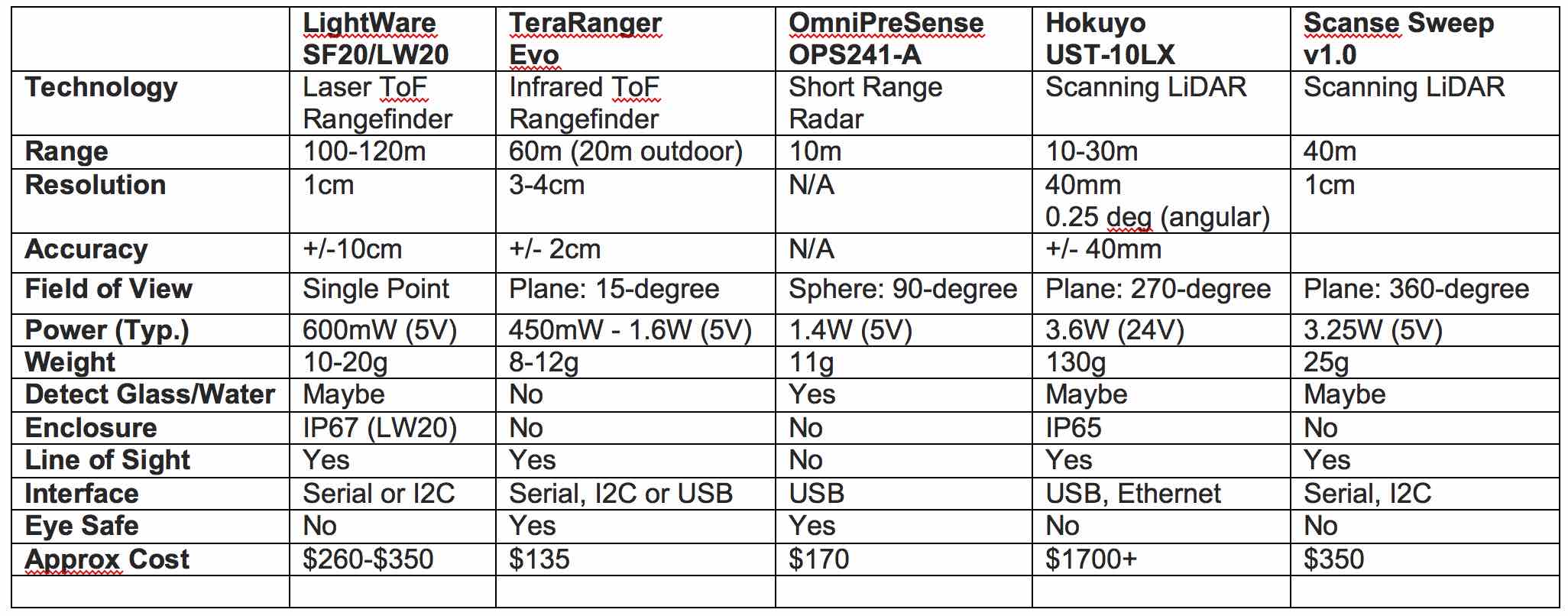How to Choose the Right Sensor Technology
Advances in LiDAR and sensor technology are driving size and cost of sensors down rapidly, while improving performance dramatically.
The Acroname team has put together this short guide to help make some sense of the technologies available today:
Laser Rangefinders:
Use lasers and Time of Flight (ToF) principles to determine distance to an object.
Pros: Excellent distance capabilities, very lightweight, excellent accuracy.
Cons: Single point measurements, eye safety concerns.
Considerations: Laser signals require a direct line of sight and will penetrate glass and water, so these glass or water are difficult to detect using laser technology. Some signal processing can be performed to examine first-return pulses from the sensor, which may indicate a glass or translucent surface. Lasers can have very narrowly focused beams, which makes them very accurate when measuring specific points.
When to use: Excellent for use as an altimeter, collision avoidance, detecting traffic or distance measurement.
Scanning LiDAR:
Uses laser rangefinders to sweep the sensor across a Field of View (FoV) in a plane.
Attached to a servo motor, its output is a series of points in the plane of rotation of the sensor.
Pros: Medium distance capabilities, excellent accuracy, planar FoV.
Cons: Rotation mechanics reqire increased size power, weight and cost vs single point sensors. Eye safety concerns, requires higher power than single point rangefinders. Requires more computing power to process sensor data than single point range finders.
Considerations: See Laser Rangefinders above. Some additional considerations may be needed for the increased size and weight of scanning sensors.
When to use: Excellent for use in mapping applications, collision avoidance, human/machine and industrial safety.
Infrared LED Rangefinders:
Use infrared LEDs and Time of Flight (ToF) principles to determine distance to an object.
Pros: Medium distance capabilities, very lightweight, very low cost, no eye-safety concerns.
Cons: Performance can be impacted by ambient light or outdoor environments.
Considerations: LED signals, like lasers, require a direct line of sight and will penetrate glass and water, so these glass or water are difficult to detect using LED technology. LEDs produce longer wavelength and therefore also produce a wider FoV to the target objects than laser-based technologies.
When to use: Altimeters, collision avoidance, human or vehicle traffic detection, distance measurement. Ideal for use when eye-safety considerations or wider FoV is required.
Short-Range Radar:
Uses high-frequency radar and processing of Doppler-effect reflections to sense movement or distance in a spatial volume.
(View our most popular doppler sensor)
Pros: Medium distance capabilities, very lightweight, detects glass and water, can be placed behind opaque surfaces.
Cons: No enclosure, constant wave (CW) implementations do not provide distance data.
Considerations: Unlike optical technologies, with some consideration to materials, radar modules can be placed behind opaque surfaces. Glass or water are not penetrated by radar, so are detected using radar technology. Specific distance and direction are not provided using CW implementations. Some consideration should be made to cosine effects of objects moving parallel to radar sensors.
When to use: Speed/direction detection, collision avoidance, human or vehicle traffic detection, distance measurement. Ideal for use when eye-safety considerations, spatial FoV or placing the sensor behind an opaque barrier is required.
Laser comparison chart to help guide your selection:
If you have any questions about which technology may be right for you, we will be happy to discuss your application and specific needs. Please contact us at:
sales@acroname.com or
support@acroname.com

Add New Comment